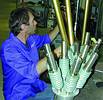
Although the mass manufacture of electronic components and devices has moved to the cheap conditions that exist in the Far East and China, South Africa is still holding its own in niche areas of production where global competitiveness requires intimate product knowledge and innovation rather than just low cost production. One of these areas is antenna development and manufacture, as exemplified by the local company, the Poynting Group.
The history of Poynting can actually be traced back to 1990 through the company Givati, Fourie and Associates (GFA) that provided a specialist electromagnetic consulting service, mainly in the field of antenna design. In 1997, taking cognisance of the opportunities beyond just consulting work, one of the founders of GFA, Dr Andre Fourie, created Poynting Innovations, initially as the sole shareholder. Jurgen Dresel, the only other engineer in the company when it was founded, soon became a major shareholder, and Derek Nitch followed him when what is now known as Poynting Software was purchased in 1998. The final part of Andre's plan came to fruition in 2001 with the establishment of an antenna manufacturing capability (Poynting Antennas) following the relocation of the company (the Poynting Group) from the Wits campus to a new 1400 m2 facility in Wynberg.

Today the group has a staff complement of 45 people, the high-tech nature of the business being reflected by the fact that 12 of these are qualified engineers (two with a PhD and four with MSc degrees). The prototyping department, critical for new antenna development and bridging the gap between software predictions and reality, houses another seven skilled technicians with electronic and mechanical backgrounds. In the full scale manufacturing facility a further 15 people are employed on a full time basis, and while the manufacturing is supported by many bought-in components and mouldings, a fully equipped mechanical workshop is available to support prototyping. Electronic assembly is very flexible with technicians working from pre-selected component kits. They work to an example of the finished product displayed in front of them. This process allows rapid changes to the product line under assembly and all the technicians are multiskilled, which allows smaller scale production runs to be undertaken at minimum cost.

Poynting continues to maintain its close association with the University of the Witwatersrand, with CEO Andre Fourie still remaining a part-time Professor there. Much collaborative work is also carried out with the University. Poynting 'challenges' provide fuel for MSc dissertations and the University also provides a flow of skilled engineering staff. While Poynting has its own in-house anechoic chamber and other test facilities it is able to make use of the more extensive test facilities available at Wits and also at the University of Pretoria.

As a company, Poynting specialises in three interrelated fields, these being antenna simulation software, antenna development, and antenna manufacture. The company takes great pride in its core strength, which is its ability to cover the full spectrum from theoretical design through prototyping and testing to full manufacture. Its ability to cost-effectively produce small production runs (50 or less) of antennas provides it with a major competitive edge. Besides developing antenna systems for others, the company also continues to expand its own line of off-the-shelf antennas for specific tasks.
The project experience of Poynting is vast, with antenna applications that include static systems, vehicle, aircraft and UAV use, mining, military and commercial applications, with areas of use that include GSM, RFID, vehicle tracking, TV, and transponder landing applications. Poynting has successfully undertaken work for most of South Africa's leading defence and telecommunications companies while at the same time about 50% of its business is International, projects being undertaken for world-leading antenna companies in the UK, France, USA and Greece, to name but a few. Many antennas are also exported into the rest of Africa. Core to its success in many of these projects is its 'SuperNEC EM simulation software', developed in-house and continually being expanded in terms of its capabilities.
A recent success for Poynting was its award of a multimillion Rand, 20-month contract for the supply of EW antennas to Athens-based company Elson. The design of these antennas for military use was of course nothing new for Poynting but the local company hopes that it is just the beginning of a long-term relationship with the Greek company.
The antennas to be supplied will be used for the transmission of high power radio waves and the monitoring of the frequency spectrum over a very wide band. The antenna system was custom-designed by Poynting and manufacture is already underway. The antennas were designed primarily for vehicle mounting but they are easily adapted for mounting on containers or other structures required by the end user. The antennas can be disassembled into sections, for ease of storage and transport, rapid assembly being possible at the point of use.
While many of its antenna systems are for military use, Poynting late last year announced the release of a range of antennas designed for communication in mines or tunnels, operating in the 900, 1800 and 2400 MHz bands. Both two-way and one-way versions are available, the former being used on straight sections while the latter is used to negotiate tunnel junctions or bends.
The MinePoynt antenna has been successfully tested in both gold mines and the Du Toits Kloof Tunnel. In the latter case, a single two-way antenna was placed at the centre of the tunnel and provided coverage of 2,5 km to either side (the entire length of the tunnel). Enquiries regarding the MinePoynt have already been received from countries as far away as Canada and Australia. There is also great local interest from the mining industry as the installed cost per metre is significantly less than the existing leaky feeder systems.
Another recent development for the mining industry was a low profile antenna for use on mine trains. This rugged antenna operates in the 915 MHz band and offers improved communications for the train operator. The first batch of 75 systems has already been delivered to the customer, Battery Electric.
In terms of off-the-shelf products, Poynting offers a wide range of products including a novel mast-mounted antenna to improve cellphone reception in remote areas (and urban poor reception areas). Other standard products include a range of GSM/cellular antennas, satellite, omni-directional, folded dipole and mast antennas. The Poynting ISM/WLAN antenna is fast becoming the industry standard for use in wireless LAN infrastructure.
The antenna business is growing rapidly and an area of greatly increased activity for Poynting is embedded antennas, the company having been contracted by several other companies to develop these devices for both cellular and wireless LAN applications. Consumer devices incorporating GSM/WLAN radio modules are more attractive and reliable if the antenna is located within the enclosure. At the other end of the spectrum, vehicle tracking system suppliers require customised antennas that are suitable for hiding within the vehicle. Poynting has already developed a number of these embedded and OEM devices and these include:
* A 900/1800 MHz embedded antenna for a smart phone.
* An 'end of coax' dual band detector for use in a vehicle tracking application.
* Antennas for integration into phone booths.
* A dual band GSM and (separate) WLAN antenna integrated into a handheld reader.
An exciting area of new development is broadband power splitters that operate in the 800 to 2200 MHz range. This power splitting technology has been perfected by Poynting and a lot of routers or GSM devices can be integrated onto a single antenna. Making the power splitter to cover this extensive bandwidth is, however, unique.
As for the future, Poynting is looking forward to further expansion of its local and global marketplace. The company will continue to build on its core antenna development skills to keep itself at the forefront of this technology.
For more information contact Poynting Innovations, 011 262 5155, [email protected].

© Technews Publishing (Pty) Ltd | All Rights Reserved